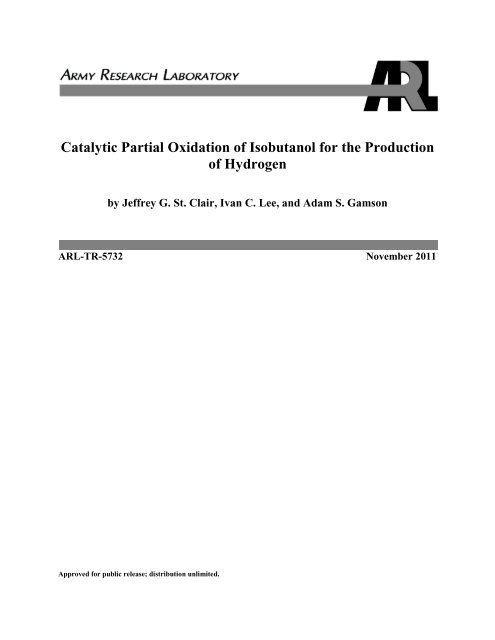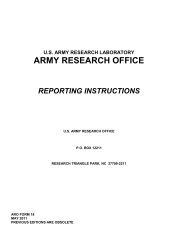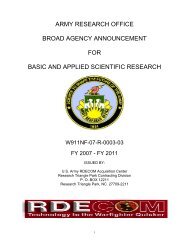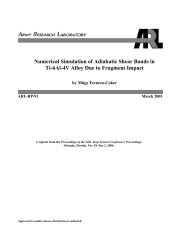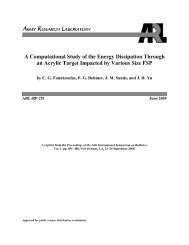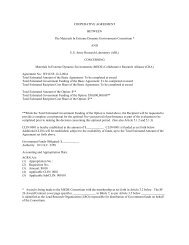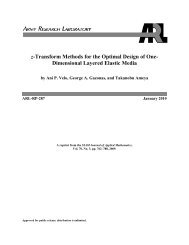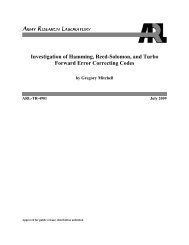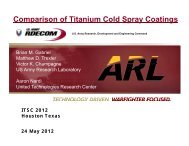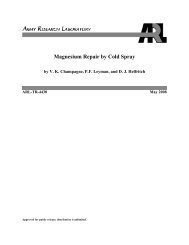Catalytic Partial Oxidation of Isobutanol for the Production of Hydrogen
Catalytic Partial Oxidation of Isobutanol for the Production of Hydrogen
Catalytic Partial Oxidation of Isobutanol for the Production of Hydrogen
Create successful ePaper yourself
Turn your PDF publications into a flip-book with our unique Google optimized e-Paper software.
<strong>Catalytic</strong> <strong>Partial</strong> <strong>Oxidation</strong> <strong>of</strong> <strong>Isobutanol</strong> <strong>for</strong> <strong>the</strong> <strong>Production</strong><br />
<strong>of</strong> <strong>Hydrogen</strong><br />
by Jeffrey G. St. Clair, Ivan C. Lee, and Adam S. Gamson<br />
ARL-TR-5732 November 2011<br />
Approved <strong>for</strong> public release; distribution unlimited.
NOTICES<br />
Disclaimers<br />
The findings in this report are not to be construed as an <strong>of</strong>ficial Department <strong>of</strong> <strong>the</strong> Army position<br />
unless so designated by o<strong>the</strong>r authorized documents.<br />
Citation <strong>of</strong> manufacturer’s or trade names does not constitute an <strong>of</strong>ficial endorsement or<br />
approval <strong>of</strong> <strong>the</strong> use <strong>the</strong>re<strong>of</strong>.<br />
Destroy this report when it is no longer needed. Do not return it to <strong>the</strong> originator.
Army Research Laboratory<br />
Adelphi, MD 20783-1197<br />
ARL-TR-5732 November 2011<br />
<strong>Catalytic</strong> <strong>Partial</strong> <strong>Oxidation</strong> <strong>of</strong> <strong>Isobutanol</strong> <strong>for</strong> <strong>the</strong> <strong>Production</strong><br />
<strong>of</strong> <strong>Hydrogen</strong><br />
Jeffrey G. St. Clair, Ivan C. Lee, and Adam S. Gamson<br />
Sensors and Electron Devices Directorate, ARL<br />
Approved <strong>for</strong> public release; distribution unlimited.
REPORT DOCUMENTATION PAGE<br />
Form Approved<br />
OMB No. 0704-0188<br />
Public reporting burden <strong>for</strong> this collection <strong>of</strong> in<strong>for</strong>mation is estimated to average 1 hour per response, including <strong>the</strong> time <strong>for</strong> reviewing instructions, searching existing data sources, ga<strong>the</strong>ring and maintaining <strong>the</strong><br />
data needed, and completing and reviewing <strong>the</strong> collection in<strong>for</strong>mation. Send comments regarding this burden estimate or any o<strong>the</strong>r aspect <strong>of</strong> this collection <strong>of</strong> in<strong>for</strong>mation, including suggestions <strong>for</strong> reducing <strong>the</strong><br />
burden, to Department <strong>of</strong> Defense, Washington Headquarters Services, Directorate <strong>for</strong> In<strong>for</strong>mation Operations and Reports (0704-0188), 1215 Jefferson Davis Highway, Suite 1204, Arlington, VA 22202-4302.<br />
Respondents should be aware that notwithstanding any o<strong>the</strong>r provision <strong>of</strong> law, no person shall be subject to any penalty <strong>for</strong> failing to comply with a collection <strong>of</strong> in<strong>for</strong>mation if it does not display a currently valid<br />
OMB control number.<br />
PLEASE DO NOT RETURN YOUR FORM TO THE ABOVE ADDRESS.<br />
1. REPORT DATE (DD-MM-YYYY)<br />
Novebmer 2011<br />
2. REPORT TYPE 3. DATES COVERED (From - To)<br />
4. TITLE AND SUBTITLE<br />
<strong>Catalytic</strong> <strong>Partial</strong> <strong>Oxidation</strong> <strong>of</strong> <strong>Isobutanol</strong> <strong>for</strong> <strong>the</strong> <strong>Production</strong> <strong>of</strong> <strong>Hydrogen</strong><br />
5a. CONTRACT NUMBER<br />
5b. GRANT NUMBER<br />
5c. PROGRAM ELEMENT NUMBER<br />
6. AUTHOR(S)<br />
Jeffrey G. St. Clair, Ivan C. Lee, and Adam S. Gamson<br />
5d. PROJECT NUMBER<br />
5e. TASK NUMBER<br />
5f. WORK UNIT NUMBER<br />
7. PERFORMING ORGANIZATION NAME(S) AND ADDRESS(ES)<br />
U.S. Army Research Laboratory<br />
ATTN: RDRL-SED-E<br />
2800 Powder Mill Road<br />
Adelphi MD 20783-1197<br />
8. PERFORMING ORGANIZATION<br />
REPORT NUMBER<br />
ARL-TR-5732<br />
9. SPONSORING/MONITORING AGENCY NAME(S) AND ADDRESS(ES) 10. SPONSOR/MONITOR’S ACRONYM(S)<br />
11. SPONSOR/MONITOR'S REPORT<br />
NUMBER(S)<br />
12. DISTRIBUTION/AVAILABILITY STATEMENT<br />
Approved <strong>for</strong> public release; distribution unlimited.<br />
13. SUPPLEMENTARY NOTES<br />
14. ABSTRACT<br />
<strong>Catalytic</strong> partial oxidation <strong>of</strong> isobutanol was investigated at various contact times, as were equivalence ratios, <strong>for</strong> <strong>the</strong> purpose <strong>of</strong><br />
H 2 production. The reactor was tested using a γ-Al 2 O 3 -coated foam as a catalyst, as well as a similar foam with rhodium (Rh)<br />
added. Both catalysts achieved isobutanol conversion greater than 99% at an operating temperature <strong>of</strong> 500 °C <strong>for</strong> a contact<br />
time <strong>of</strong> 25 ms. The results show little H 2 is produced when <strong>the</strong> Rh is absent, whereas selectivities as high as 62.92% were<br />
achieved with <strong>the</strong> noble metal present. The alumina catalyst also displays no complete combustion regime <strong>for</strong> fuel lean<br />
combustion; instead, olefins, carbon dioxide (CO 2 ), and water are <strong>the</strong> dominant products at all equivalence ratios. With<br />
approximately 8.25 W <strong>of</strong> isobutanol, 3.61 W <strong>of</strong> H 2 can be attained with <strong>the</strong> Rh catalyst <strong>for</strong> use in small power devices, such as a<br />
proton exchange membrane fuel cell.<br />
15. SUBJECT TERMS<br />
<strong>Isobutanol</strong>, combustion, partial oxidation, hydrogen<br />
16. SECURITY CLASSIFICATION OF:<br />
a. REPORT<br />
UNCLASSIFIED<br />
b. ABSTRACT<br />
UNCLASSIFIED<br />
c. THIS PAGE<br />
UNCLASSIFIED<br />
17. LIMITATION<br />
OF ABSTRACT<br />
UU<br />
ii<br />
18. NUMBER<br />
OF PAGES<br />
20<br />
19a. NAME OF RESPONSIBLE PERSON<br />
Ivan C. Lee<br />
19b. TELEPHONE NUMBER (Include area code)<br />
(301) 394-0292<br />
Standard Form 298 (Rev. 8/98)<br />
Prescribed by ANSI Std. Z39.18
Contents<br />
List <strong>of</strong> Figures<br />
iv<br />
1. Introduction 1<br />
2. Experimental 2<br />
3. Results 5<br />
4. Discussion 9<br />
4.1 Reaction Pathway ............................................................................................................9<br />
4.2 <strong>Hydrogen</strong> <strong>Production</strong> ....................................................................................................11<br />
4.3 Temperature Pr<strong>of</strong>ile .......................................................................................................11<br />
5. Conclusions 12<br />
6. References 13<br />
Distribution List 14<br />
iii
List <strong>of</strong> Figures<br />
Figure 1. Schematic <strong>of</strong> adiabatic reactor (not to scale). ..................................................................3<br />
Figure 2. <strong>Hydrogen</strong> selectivity <strong>of</strong> <strong>the</strong> reactor products <strong>for</strong> a contact time <strong>of</strong> (a) 70, ( b) 135,<br />
and (c) 270 ms using <strong>the</strong> alumina catalyst (i.e., without rhodium). ..........................................6<br />
Figure 3. <strong>Hydrogen</strong> selectivity <strong>of</strong> <strong>the</strong> reactor products <strong>for</strong> a contact time <strong>of</strong> (a) 70, (b) 135,<br />
and (c) 270 ms using <strong>the</strong> rhodium catalyst. ..............................................................................7<br />
Figure 4. A H 2 produced per amount <strong>of</strong> isobutanol at various contact times and equivalence<br />
ratios. ..........................................................................................................................................8<br />
Figure 5. Temperatures recorded at <strong>the</strong> backface <strong>of</strong> <strong>the</strong> catalyst are given with solid lines.<br />
Dashed lines represent isobutanol conversion to o<strong>the</strong>r species. Contact time: 70 ms. .............8<br />
iv
1. Introduction<br />
As technology improves, power requirements increase with a decreasing size envelope.<br />
Although batteries can provide power <strong>for</strong> small applications, such as personal electronics or<br />
small unmanned aerial vehicles (UAVs), <strong>the</strong>y generally cannot provide it <strong>for</strong> an extended amount<br />
<strong>of</strong> time. To this end, much research has been invested into alternative sources <strong>of</strong> power with a<br />
longer endurance. One alternative is a fuel cell. Fuel cells employ <strong>the</strong> high gravimetric energy<br />
density <strong>of</strong> H 2 , but this fuel needs to be stored in a manner that does not dampen <strong>the</strong> effective<br />
energy density <strong>of</strong> <strong>the</strong> power system. Storing enough gaseous hydrogen (H) <strong>for</strong> long-duration<br />
operation requires a high-pressure, heavy storage tank, increasing system mass to unacceptable<br />
levels <strong>for</strong> small scale applications. Instead, liquid, energy-dense fuels can be re<strong>for</strong>med to<br />
produce H 2 , which can <strong>the</strong>n be fed directly to <strong>the</strong> fuel cell. There<strong>for</strong>e, an improvement in H<br />
production will lead to <strong>the</strong> advancement <strong>of</strong> smaller and smarter technology.<br />
Several fuels are being investigated <strong>for</strong> fuel processing applications, including alcohols like<br />
methanol and ethanol. Salge et al. investigated <strong>the</strong> catalytic partial oxidation <strong>of</strong> ethanol and<br />
ethanol-water mixtures; high H selectivities (above 80%) were achieved using a rhodium (Rh)-<br />
ceria (CeO 2 ) catalyst at short contact times (~10 ms) (7). This catalyst has also been used to<br />
re<strong>for</strong>m methanol, 1-propanol, and 2-propanol with similarly promising high H 2 selectivities (8).<br />
It was found, however, that without <strong>the</strong> Ceria coating, <strong>the</strong> reactor operated at higher temperatures<br />
with less successful results. This could mean that <strong>the</strong> Rh requires certain catalytic reactions to<br />
take place be<strong>for</strong>e it can produce <strong>the</strong> desired H 2 , and that <strong>the</strong>se reactions occur on <strong>the</strong> surface <strong>of</strong><br />
<strong>the</strong> support coating.<br />
Little work has been done in <strong>the</strong> catalytic re<strong>for</strong>ming <strong>of</strong> heavier alcohols, such as butanol.<br />
Butanol isomers are an attractive renewable fuel source; <strong>the</strong> alcohol can be syn<strong>the</strong>sized using<br />
yeasts or bacteria, such as E. coli (1–4). Butanol has a higher energy density than both methanol<br />
and ethanol, and a lower hygroscopicity, easing <strong>the</strong> issues <strong>of</strong> storage and transport associated<br />
with ethanol. Previous work by Behrens et al., however, reports that ethanol has a higher H 2<br />
selectivity than 1-butanol when using Rh/alumina as a catalyst (5). 2-butanol has been<br />
decomposed using a Pt/ZrO 2 catalyst <strong>for</strong> H production (12). It was found that at temperatures<br />
below 275 °C, dehydrogenation is <strong>the</strong> dominant decomposition pathway; but above this<br />
temperature, dehydration occurs to produce water instead <strong>of</strong> H 2 . This change was attributed to<br />
carbon build-up on <strong>the</strong> catalyst surface and <strong>the</strong> alkenes blocking interfacial sites. <strong>Isobutanol</strong> has<br />
been <strong>the</strong> preferred fuel to syn<strong>the</strong>size recently, due to its high yield production (1). Branchedchain<br />
alcohols also are known to have higher octane numbers than <strong>the</strong> straight-chain isomers.<br />
Taylor et al. <strong>for</strong>med linear and branched butenes from isobutanol by dehydrating it over gammaalumina<br />
catalysts (6). These butenes could be fur<strong>the</strong>r used to create o<strong>the</strong>r fuels like gasoline and<br />
butyl rubber.<br />
1
In catalytic conversion, <strong>the</strong> time <strong>the</strong> reactant has to react with <strong>the</strong> surface has been shown to play<br />
a prominent role in product composition (7–9). The contact time, when considering a monolithic<br />
foam, is determined by <strong>the</strong> volume <strong>of</strong> <strong>the</strong> foam, <strong>the</strong> volume flow rate <strong>of</strong> <strong>the</strong> reactants, and <strong>the</strong><br />
operating temperature <strong>of</strong> <strong>the</strong> catalyst foam. With a large enough contact time, <strong>the</strong> chemistry<br />
within <strong>the</strong> reactor will reach its equilibrium condition. When operating at shorter times,<br />
however, intermediate molecules will still be present in <strong>the</strong> exhaust. The kinetic pathways at<br />
<strong>the</strong>se contact times <strong>the</strong>n play a greater role in what is produced.<br />
The equivalence ratio (), which compares <strong>the</strong> actual fuel-to-air ratio <strong>of</strong> <strong>the</strong> reactor to <strong>the</strong><br />
stoichiometric fuel-to-air ratio, also plays an important role in fuel re<strong>for</strong>ming. A -value <strong>of</strong> unity<br />
signifies a stoichiometric feed <strong>of</strong> fuel and air, which, <strong>for</strong> butanol, is given as<br />
CH 3 CH 2 CH 2 CH 2 OH + 6 O 2 4 CO 2 + 5 H 2 O ΔH = -2713 kJ/mol. (1)<br />
The -value can be controlled by adjusting <strong>the</strong> amount <strong>of</strong> fuel and/or oxygen (O 2 ) fed to <strong>the</strong><br />
reactor. A condition where <strong>the</strong> -value is greater than unity is considered “fuel rich,” and<br />
incomplete combustion occurs because not enough O is present to combust <strong>the</strong> entire amount <strong>of</strong><br />
fuel; <strong>the</strong> incomplete combustion process is also known as partial oxidation. Running slightly<br />
fuel rich (1
flow uni<strong>for</strong>mity. The mixing foam was 1 cm in thickness. The inner diameter <strong>of</strong> <strong>the</strong> reactor was<br />
2 cm.<br />
Figure 1. Schematic <strong>of</strong> adiabatic reactor (not to scale).<br />
The catalyst was located 12.5 cm below <strong>the</strong> grounded mesh. Blank alumina foams (45 ppi) with<br />
a thickness <strong>of</strong> 1 cm were placed above and below <strong>the</strong> catalyst. The foams primarily acted as heat<br />
shields but also as ano<strong>the</strong>r mixing layer to ensure uni<strong>for</strong>mity <strong>of</strong> <strong>the</strong> fuel vapor over <strong>the</strong> entire<br />
catalyst surface. Two types <strong>of</strong> catalysts were tested. Both were built using an alumina monolith<br />
foam (Vesuvius, 80 ppi, 17 mm diameter, 1 cm thick), which was coated with -alumina to<br />
roughen <strong>the</strong> foam surface and to increase <strong>the</strong> surface area. The foams were calcined in a box<br />
furnace at 700 °C <strong>for</strong> 15 h. One <strong>of</strong> <strong>the</strong> foams was set aside at this point, and will be referred to<br />
as <strong>the</strong> alumina catalyst. An aqueous Rh(NO 3 ) 3 solution was added to <strong>the</strong> o<strong>the</strong>r foam, and <strong>the</strong><br />
resultant foam was again calcined in <strong>the</strong> box furnace at 700 °C <strong>for</strong> ano<strong>the</strong>r 15 h. This foam will<br />
be referred to as <strong>the</strong> Rh catalyst. The foam contained 0.07353 g <strong>of</strong> Rh and was prepared in <strong>the</strong><br />
manner detailed in <strong>the</strong> literature (11).<br />
Sufficient heat was supplied via heating tape to <strong>the</strong> grounded mesh and mixing foam (generally a<br />
few degrees above <strong>the</strong> boiling point <strong>of</strong> <strong>the</strong> fuel) to ensure complete vaporization and catalytic<br />
ignition. Typical catalyst ignition temperature was approximately 240 °C. Below <strong>the</strong> heating<br />
tape, insulation was wrapped around <strong>the</strong> reactor—including <strong>the</strong> catalyst portion—to impose<br />
adiabatic conditions. Temperatures were observed at <strong>the</strong> nozzle, ground mesh, and catalyst, and<br />
were used just as a reference. The effluent gas exits <strong>the</strong> reactor, where it is sent through an<br />
Agilent four-channel micro gas chromatograph (GC).<br />
These GC measurements are vital in determining how much H is being produced and what o<strong>the</strong>r<br />
byproducts may also be present. The amounts <strong>of</strong> H, O, N, carbon monoxide (CO), CO 2 , and<br />
methane, ethylene, ethane, acetylene, propane, propylene, 2-butyne, butane, isobutane, 1-butene,<br />
t-2 butene, c-2 butene, isobutylene, 1,2-butadiene, 1,3-butadiene, pentane, ethyl acetylene, 1-<br />
pentene, t-2 pentene, c-2 pentene, hexane, 1-hexene, t-2 hexene, and c-2 hexene were monitored<br />
using <strong>the</strong> four-channel micro-GC. Be<strong>for</strong>e each experiment, N was passed through <strong>the</strong> reactor to<br />
3
clear out any lingering gases and to ensure no leaks in <strong>the</strong> system. Heating tape was activated to<br />
provide heat to <strong>the</strong> region between <strong>the</strong> fuel atomizer and <strong>the</strong> catalyst. Then <strong>the</strong> appropriate N<br />
and O flow rates were set to give <strong>the</strong> equivalence ratio and contact time desired. Once <strong>the</strong><br />
temperatures reached a steady state, <strong>the</strong> voltage differential between <strong>the</strong> ground mesh and <strong>the</strong><br />
stainless steel tube was established to electrospray, and fuel flow was initiated. Voltages were<br />
<strong>the</strong>n adjusted to maintain electrospray stability in cone-jet mode as needed. The temperatures<br />
were again allowed to reach a steady state operating condition, and <strong>the</strong> GC recorded <strong>the</strong> effluent<br />
gas composition during this time.<br />
Equivalence ratio and contact time are <strong>the</strong> two operating parameters that were varied while<br />
investigating <strong>the</strong> alumina and Rh catalysts. The equivalence ratios tested ranged from very fuel<br />
lean ( = 0.17) to fuel rich values up to = 6.34. The equivalence ratio set <strong>the</strong> total O flow rate,<br />
using a set fuel flow rate, which was generally 1 mL h –1 . At higher values, <strong>the</strong> O flow rate<br />
would dip below 5 mL min –1 , which was too low <strong>for</strong> <strong>the</strong> flow controllers; at <strong>the</strong>se ratios, <strong>the</strong> fuel<br />
would be increased, instead, to keep <strong>the</strong> O flow rate at acceptable levels <strong>for</strong> <strong>the</strong> flow controllers.<br />
The nitrogen flow rate was adjusted <strong>for</strong> each O flow rate to ensure <strong>the</strong> total volumetric flow rate<br />
<strong>of</strong> gas remained <strong>the</strong> same. This guaranteed that <strong>the</strong> contact time inside <strong>the</strong> reactor remained <strong>the</strong><br />
same, within 5 ms, while <strong>the</strong> equivalence ratio was varied. The contact times are calculated at<br />
<strong>the</strong> catalyst backface temperature.<br />
Fuel conversion was observed using syringe samples <strong>of</strong> <strong>the</strong> effluent gas in a separate GC with an<br />
Innowax column, a flame ionization detector (FID) (Agilent 6890). The column was set to<br />
detect acetaldehyde, acetone, methanol, 2-butanone, 1 or 2 butanol, and isobutanol. Water was<br />
not detected using GC, but calculated using an O species balance <strong>of</strong> <strong>the</strong> compounds detected that<br />
contain O:<br />
O<br />
water<br />
O O O . (2)<br />
in<br />
microGC<br />
FIDGC<br />
Conversion was defined as <strong>the</strong> amount <strong>of</strong> isobutanol in <strong>the</strong> effluent gas compared to <strong>the</strong> initial<br />
amount entering <strong>the</strong> reactor. Thus, if no peak appeared at <strong>the</strong> retention time <strong>of</strong> isobutanol <strong>for</strong> a<br />
GC sample that was taken, <strong>the</strong> conversion was considered 100%. Species selectivity can be used<br />
as a metric <strong>of</strong> how complete <strong>the</strong> combustion process is, meaning how much CO 2 and H 2 O are<br />
<strong>for</strong>med compared to <strong>the</strong> stoichiometric amounts. Carbon selectivity was defined as <strong>the</strong> number<br />
<strong>of</strong> carbon atoms in a particular species, divided by <strong>the</strong> total number <strong>of</strong> carbon atoms in <strong>the</strong><br />
product gas as shown:<br />
C atom Selectivity <br />
# C in Species X<br />
C in product<br />
<br />
(3)<br />
Thus, if <strong>the</strong> carbon selectivity <strong>of</strong> CO 2 is 100%, complete combustion has occurred. Similarly, H<br />
selectivity was defined as <strong>the</strong> number <strong>of</strong> H atoms in a particular species divided by <strong>the</strong> total<br />
number <strong>of</strong> H atoms in <strong>the</strong> product gas. This represents <strong>the</strong> percentage <strong>of</strong> converted H atoms in<br />
each <strong>of</strong> <strong>the</strong> species studied and is analogous to equation 3 if H is substituted <strong>for</strong> carbon.<br />
4
3. Results<br />
<strong>Catalytic</strong> partial oxidation <strong>of</strong> isobutanol was studied using <strong>the</strong> catalyst that did not contain Rh.<br />
The reactor was operated at three contact times—25, 56, and 125 ms—at ignition backface<br />
temperatures <strong>of</strong> 460, 420, and 290 °C, respectively. The results using <strong>the</strong> alumina catalyst are<br />
shown in figure 2. For all three contact times, <strong>the</strong> vast majority <strong>of</strong> products were olefins and<br />
water. H is <strong>for</strong>med, but at small amounts. The largest selectivity value using <strong>the</strong> alumina<br />
catalyst was at a contact time <strong>of</strong> 125 ms and a = 6.3377, with a value <strong>of</strong> 1.59%.<br />
The H selectivity using <strong>the</strong> Rh catalyst at each contact time is given in figure 3, with similar<br />
ignition backface temperatures as previously stated. For all contact times, fuel lean conditions<br />
exhibit complete combustion when using a Rh catalyst. Fuel rich conditions cause syngas (H 2<br />
and CO) and residual hydrocarbons to appear in <strong>the</strong> exhaust gas. H 2 selectivity has a maximum<br />
point in each contact time, whereas olefin production increases with increasing equivalence ratio.<br />
The major product within <strong>the</strong> olefin category was isobutylene. Trace amounts <strong>of</strong> paraffins are<br />
found in all cases, usually in <strong>the</strong> <strong>for</strong>m <strong>of</strong> methane and propane. For <strong>the</strong> 25 ms contact time, <strong>the</strong><br />
maximum selectivity to H 2 was at = 3.501 with a value <strong>of</strong> 52.15%. At <strong>the</strong> o<strong>the</strong>r two times, 56<br />
and 125 ms, <strong>the</strong> maximums were observed at = 1.4248, with values <strong>of</strong> 62.92% and 24.65%,<br />
respectively. The production <strong>of</strong> H as a ratio <strong>of</strong> fuel input at all contact times and equivalence<br />
ratios tested using <strong>the</strong> Rh catalyst is provided in figure 4. The maximum is 995 sccm H 2 per<br />
sccm <strong>of</strong> isobutanol.<br />
The temperature <strong>of</strong> <strong>the</strong> catalyst, more specifically, its backface in <strong>the</strong> flow field, was recorded <strong>for</strong><br />
each test. Figure 5 presents <strong>the</strong> final catalyst backface temperatures as a function <strong>of</strong> <strong>the</strong><br />
equivalence ratio, <strong>for</strong> <strong>the</strong> contact time <strong>of</strong> 25 ms. The o<strong>the</strong>r two contact times show a similar<br />
trend. The alumina catalyst fluctuates little in temperature, whereas <strong>the</strong> Rh catalyst operates at<br />
higher temperatures in fuel lean conditions. The fuel rich temperatures <strong>for</strong> both catalysts<br />
generally do not show an increase from <strong>the</strong> baseline temperature, which is <strong>the</strong> temperature be<strong>for</strong>e<br />
<strong>the</strong> fuel is initiated.<br />
The conversion <strong>of</strong> isobutanol to o<strong>the</strong>r compounds is also shown in figure 5. With a Rh catalyst,<br />
no remaining isobutanol was detected at lower equivalence ratios. Increasing amounts <strong>of</strong><br />
isobutanol were observed at higher values. The alumina catalyst does not show a particular<br />
trend; however, isobutanol was detected at all equivalence ratios tested. With both catalysts, <strong>the</strong><br />
conversion <strong>of</strong> isobutanol to some o<strong>the</strong>r product appears to be high (above 99%).<br />
5
Figure 2. <strong>Hydrogen</strong> selectivity <strong>of</strong> <strong>the</strong> reactor products <strong>for</strong> a contact time <strong>of</strong> (a) 70, ( b) 135, and<br />
(c) 270 ms using <strong>the</strong> alumina catalyst (i.e., without rhodium).<br />
6
Figure 3. <strong>Hydrogen</strong> selectivity <strong>of</strong> <strong>the</strong> reactor products <strong>for</strong> a contact time <strong>of</strong> (a) 70, (b) 135, and<br />
(c) 270 ms using <strong>the</strong> rhodium catalyst.<br />
7
Figure 4. A H 2 produced per amount <strong>of</strong> isobutanol at various contact times and equivalence ratios.<br />
Figure 5. Temperatures recorded at <strong>the</strong> backface <strong>of</strong> <strong>the</strong> catalyst are given with solid lines. Dashed<br />
lines represent isobutanol conversion to o<strong>the</strong>r species. Contact time: 70 ms.<br />
8
4. Discussion<br />
4.1 Reaction Pathway<br />
Figures 2 and 3 <strong>of</strong>fer excellent insight into <strong>the</strong> reaction pathway taken in isobutanol catalytic<br />
combustion. Although o<strong>the</strong>r pathways may be present, <strong>the</strong> following proposed pathway is<br />
consistent with <strong>the</strong> experimental results. The first step is known as dehydration <strong>of</strong> <strong>the</strong><br />
isubutanol, <strong>for</strong>ming olefins and water:<br />
iso-C 4 H 9 OH C 4 H 8 + H 2 O (4)<br />
This reaction is consistent with <strong>the</strong> study <strong>of</strong> 2-butanol decomposition (12), because <strong>the</strong> operating<br />
temperatures were always above 275 °C. The following steps are taken to complete combustion<br />
and require O to do so.<br />
<strong>Partial</strong> oxidation <strong>of</strong> olefins:<br />
<strong>Oxidation</strong> <strong>of</strong> H 2 :<br />
<strong>Oxidation</strong> <strong>of</strong> CO:<br />
C 4 H 8 + 2 O 2 4 CO + 4 H 2 (5)<br />
H 2 + 0.5 O 2 H 2 O (6)<br />
CO + 0.5 O 2 CO 2 (7)<br />
Consider <strong>the</strong> selectivities <strong>of</strong> catalytic partial oxidation <strong>of</strong> isobutanol using <strong>the</strong> alumina catalyst<br />
(figure 2) in <strong>the</strong> fuel lean region ( < 1). The selectivity <strong>of</strong> water is higher than olefins, implying<br />
that much <strong>of</strong> <strong>the</strong> fuel is completely combusted. Some olefins remain, however, meaning that not<br />
all <strong>the</strong> olefins are partially oxidized. As <strong>the</strong> equivalence ratio increases to <strong>the</strong> mid range region<br />
( = 1.4248), <strong>the</strong> longer contact time is required to progress to combustion. The shorter two<br />
contact times (25 ms, 56 ms) limit <strong>the</strong> reactions in equations 5–7. In <strong>the</strong> higher range, even <strong>the</strong><br />
longest contact time (125 ms) is not slow enough, such that only half <strong>the</strong> H atoms are converted<br />
to water, while <strong>the</strong> o<strong>the</strong>r half are in <strong>the</strong> <strong>for</strong>m <strong>of</strong> olefins due to dehydration from <strong>the</strong> reaction in<br />
equation 4. The trend <strong>of</strong> decreasing water selectivity with equivalence ratio is in part due to <strong>the</strong><br />
decrease in O relative to <strong>the</strong> fuel, making <strong>the</strong> oxidation reactions harder to achieve; O was found,<br />
however, in <strong>the</strong> product gas in all cases using <strong>the</strong> alumina catalyst. H and CO were found in<br />
trace amounts (
However, because little, if any, H was observed using <strong>the</strong> alumina catalyst, dehydrogenation<br />
does not appear to have taken place. The alumina results also indicate that <strong>the</strong> reactions <strong>of</strong><br />
equations 4, 6, and 7 occur quickly relative to <strong>the</strong> reaction in equation 5; when olefins are<br />
partially oxidized, <strong>the</strong> syngas is quickly converted to water and CO 2 .<br />
From figure 3, fuel lean conditions show only water and CO 2 as products when Rh is added to<br />
<strong>the</strong> catalyst foam. At lean conditions, decomposition <strong>of</strong> isobutanol and oxidation <strong>of</strong> <strong>the</strong><br />
intermediate species (equations 4–7) occur on both <strong>the</strong> alumina and Rh surfaces, converting <strong>the</strong><br />
fuel into its complete combustion products. It can be assumed that isobutanol decomposition<br />
also occurs on <strong>the</strong> Rh surface, as figure 5 shows that Rh gives a slightly higher conversion <strong>of</strong><br />
isobutanol (meaning more is dehydrated in addition to <strong>the</strong> amount converted by alumina). Since<br />
<strong>the</strong> difference in conversion values is very small, most <strong>of</strong> <strong>the</strong> dehydration <strong>of</strong> isobutanol can be<br />
attributed to <strong>the</strong> alumina. This coincides with <strong>the</strong> recent literature study on 2-butanol<br />
decomposition (12), in which <strong>the</strong> authors concluded that <strong>the</strong> active sites were on <strong>the</strong> zirconia<br />
support <strong>of</strong> <strong>the</strong> Pt/ZrO 2 catalyst <strong>for</strong> dehydration.<br />
While <strong>the</strong> higher temperatures may cause deactivation <strong>for</strong> decomposition, Rh does not show<br />
decreased per<strong>for</strong>mance in oxidation. The Rh expedites <strong>the</strong> conversion process so that complete<br />
combustion does occur <strong>for</strong> fuel lean conditions at all three contact times. The olefins blocking<br />
<strong>the</strong> sites may be attributed to <strong>the</strong> change, since <strong>the</strong>y would be in a favorable position <strong>for</strong> catalytic<br />
oxidation with <strong>the</strong> Rh. Moving to a higher equivalence ratio <strong>of</strong> = 1.4248 produces H 2 <strong>for</strong> all<br />
contact times. The decrease in O when increasing <strong>the</strong> ratio means that <strong>the</strong> syngas oxidation<br />
reactions (equation 6 and 7) have less O to use, and cannot fully convert <strong>the</strong> CO and H 2 into CO 2<br />
and water, respectively. These steps suffer because <strong>the</strong> preliminary reaction, partial oxidation <strong>of</strong><br />
<strong>the</strong> olefins on both surfaces, consumes most if not all <strong>the</strong> O.<br />
The differences in magnitude <strong>of</strong> <strong>the</strong> H 2 selectivities in <strong>the</strong> presence <strong>of</strong> Rh <strong>for</strong> <strong>the</strong> three contact<br />
times explain <strong>the</strong> distribution <strong>of</strong> O, as well. First, it should be noted that unlike <strong>the</strong> alumina<br />
catalyst, no O was observed in <strong>the</strong> effluent gas. From <strong>the</strong> alumina catalyst, it is found that<br />
oxidation on <strong>the</strong> alumina surface is more favorable with a longer contact time, and that oxidation<br />
<strong>of</strong> H 2 (or CO) will happen if <strong>the</strong> olefins are partially oxidized, regardless <strong>of</strong> <strong>the</strong> equivalence ratio,<br />
leaving only a small amount <strong>of</strong> H 2 . Since <strong>the</strong> H 2 value in figure 3b is higher than that <strong>of</strong> figure<br />
3a, it is reasonable to assume that partial oxidation <strong>of</strong> olefins on <strong>the</strong> Rh surface also occurs more<br />
frequently with longer contact times. Because more O is being used in <strong>the</strong> partial oxidation <strong>of</strong><br />
olefins, less O is available <strong>for</strong> <strong>the</strong> oxidation <strong>of</strong> syngas on <strong>the</strong> Rh surface. Thus, at a contact time<br />
<strong>of</strong> 56 ms, less <strong>of</strong> <strong>the</strong> H 2 produced from partial oxidation on <strong>the</strong> Rh surface is fur<strong>the</strong>r converted<br />
than with <strong>the</strong> shorter contact time. This would also be <strong>the</strong> case with <strong>the</strong> longer time (125 ms),<br />
except that now <strong>the</strong> alumina in <strong>the</strong> catalyst is in <strong>the</strong> combustion dominant regime. At this higher<br />
contact time, oxidation on <strong>the</strong> alumina surface takes a more dominant role in converting <strong>the</strong><br />
olefins to water and CO 2 .<br />
10
Figure 3a shows a different trend in H 2 selectivity than <strong>the</strong> figures 3b and 3c. The maximum is<br />
attained at an equivalence ratio <strong>of</strong> 3.501. With <strong>the</strong> decrease in O to <strong>the</strong> new ratio, partial<br />
oxidation <strong>of</strong> <strong>the</strong> olefins on <strong>the</strong> Rh surface is still occurring, perhaps at <strong>the</strong> same rate, while<br />
reactions on <strong>the</strong> alumina surface and syngas oxidation on <strong>the</strong> Rh surface are less frequent. At <strong>the</strong><br />
o<strong>the</strong>r contact times, <strong>the</strong> H 2 selectivity has decreased, meaning that <strong>the</strong> Rh surface reaction <strong>of</strong><br />
equation 5 has been reduced with <strong>the</strong> o<strong>the</strong>rs. This scenario implies that <strong>the</strong> Rh at smaller contact<br />
times is more effective than alumina at activating O 2 <strong>for</strong> surface reactions with olefins, but also<br />
that this characteristic diminishes with increasing contact time. The rest <strong>of</strong> <strong>the</strong> data past this<br />
equivalence ratio provides <strong>the</strong> following insight: as <strong>the</strong> equivalence ratio increases, less O is<br />
available, lowering <strong>the</strong> rates <strong>of</strong> oxidation on both alumina and Rh surfaces. This means that only<br />
dehydration will occur at even larger values. Only alumina surface reactions increase in<br />
occurrence at high values when <strong>the</strong> contact time is increased. Contact times larger than those<br />
investigated here could potentially render <strong>the</strong> Rh useless; however, such contact times would not<br />
yield H <strong>for</strong> fuel cell applications.<br />
4.2 <strong>Hydrogen</strong> <strong>Production</strong><br />
From figure 4, it is clear that <strong>for</strong> maximum yield a contact time <strong>of</strong> 56 ms with an equivalence<br />
ratio around 1.4248 is desirable. At <strong>the</strong> fuel flow rate used <strong>for</strong> experimentation, 1.012 mL/hr<br />
(about 8.25 W <strong>the</strong>rmal), <strong>the</strong> reactor provided at this operating condition <strong>the</strong> equivalent <strong>of</strong> 3.61 W<br />
<strong>of</strong> H 2 . This translates to a re<strong>for</strong>mer efficiency <strong>of</strong> approximately 44%. Even <strong>the</strong> next higher<br />
equivalence ratio achieves a higher H yield than <strong>the</strong> highest peak <strong>of</strong> <strong>the</strong> 25 ms contact time,<br />
being 651 and 550 sccm H 2 /sccm isobutanol, respectively. This implies <strong>the</strong>re is an optimal<br />
contact time <strong>for</strong> H production with this catalyst, not just an optimal equivalence ratio. The<br />
optimal contact time and equivalence ratio associated with it will be <strong>the</strong> topic <strong>of</strong> future research.<br />
4.3 Temperature Pr<strong>of</strong>ile<br />
The temperature pr<strong>of</strong>iles portrayed in figure 5 concur with <strong>the</strong> reaction products <strong>of</strong> <strong>the</strong> reactor.<br />
Because <strong>the</strong> reactor is adiabatic, all energy entering <strong>the</strong> system with <strong>the</strong> reactants also leaves <strong>the</strong><br />
system with <strong>the</strong> products. In this scenario, <strong>the</strong> enthalpy released when combusting <strong>the</strong> fuel is<br />
distributed through <strong>the</strong> products, which is observed in <strong>the</strong> <strong>for</strong>m <strong>of</strong> a temperature increase. A<br />
combustion process that sees more than <strong>the</strong> complete products, CO 2 and H 2 O, is using energy to<br />
<strong>for</strong>m and sustain those byproducts. Thus, less <strong>of</strong> a temperature increase will be observed. This<br />
is <strong>the</strong> case with <strong>the</strong> alumina catalyst at all equivalence ratios tested, and <strong>the</strong> Rh catalyst at fuel<br />
rich conditions.<br />
11
5. Conclusions<br />
The energy-dense, renewable alcohol isobutanol can be re<strong>for</strong>med using catalytic combustion to<br />
produce H <strong>for</strong> use in small power applications such as PEM fuel cells. H production requires Rh<br />
when using a monolith foam coated with γ-Alumina. This is because <strong>the</strong> Rh accelerates <strong>the</strong><br />
process that decomposes olefins into H 2 and CO. The highest H selectivity observed was<br />
62.92% at an equivalence ratio <strong>of</strong> 1.4248 and a contact time <strong>of</strong> 56 ms. This operating condition<br />
provided 3.61 W <strong>of</strong> H 2 , achieving an approximate re<strong>for</strong>mer efficiency <strong>of</strong> 44%. Conversion <strong>of</strong><br />
isobutanol to o<strong>the</strong>r species was found to be above 99%.<br />
12
6. References<br />
1. Atsumi, S.; Hanai, T.; Liao, J. Non-fermentative Pathways <strong>for</strong> Syn<strong>the</strong>sis <strong>of</strong> Branched-chain<br />
Higher Alcohols as Bi<strong>of</strong>uels. Nature 2008, 451, 86–90.<br />
2. Weber, C.; Farwick, A.; Benisch, F.; Brat, D.; Dietz, H.; Subtil, T.; Boles, E. Trends and<br />
Challenges in <strong>the</strong> Microbial <strong>Production</strong> <strong>of</strong> Lignocellulosic Bbioalcohol Fuels. Appl.<br />
Microbiol Biotechnology 2010, 87, 1303–1315.<br />
3. Atsumi, S.; Wu, T.; Eckl, E.; Hawkins, S.; Buelter, T.; Liao, J. Engineering <strong>the</strong> <strong>Isobutanol</strong><br />
Biosyn<strong>the</strong>tic Pathway in Escherichia coli by Comparison <strong>of</strong> Three Aldehyde<br />
Reductase/Alcohol Dehydrogenase Genes. Appl. Microbiol Biotechnology 2010, 85, 651–<br />
657.<br />
4. Smith, K.; Cho, K.; Liao, J. Engineering Corynebacterium glutamicum <strong>for</strong> <strong>Isobutanol</strong><br />
<strong>Production</strong>. Appl. Microbiol Biotechnology 2010, 87, 1045–1055.<br />
5. Behrens, D. A.; Lee, I. C.; Waits, C. M. <strong>Catalytic</strong> Combustion <strong>of</strong> Alcohols <strong>for</strong> Microburner<br />
Applications. J. Power Sources 2010, 195, 2008–2013.<br />
6. Taylor, J.; Jenni, M.; Peters, M. Dehydration <strong>of</strong> Fermented <strong>Isobutanol</strong> <strong>for</strong> <strong>the</strong> <strong>Production</strong> <strong>of</strong><br />
Renewable Chemicals and Fuels. Top Catal. 2010, 53, 1224–1230.<br />
7. Salge, J. R.; Deluga, G. A.; Schmidt, L. D. <strong>Catalytic</strong> <strong>Partial</strong> <strong>Oxidation</strong> <strong>of</strong> Ethanol over<br />
Noble Metal Catalysts. J. Catal 2005, 235, 69–78.<br />
8. Wanat, E. C.; Suman, B.; Schmidt, L. D. <strong>Partial</strong> <strong>Oxidation</strong> <strong>of</strong> Alcohols to Produce<br />
<strong>Hydrogen</strong> and Chemicals in Millisecond Contact Time Reactors. J. Catal 2005, 235, 18–27.<br />
9. Joensen, F.; Rostrup-Nielsen, J. R. Conversion <strong>of</strong> Hydrocarbons and Alcohols <strong>for</strong> Fuel<br />
Cells. J. Power Sources 2002, 105, 195–201.<br />
10. Tang, K.; Gomez, A. Monodisperse Electrosprays <strong>of</strong> Low Electric Conductivity Liquids in<br />
<strong>the</strong> Cone-jet Mode. J. Colloid Interface Sci. 1996, 184, 500–511.<br />
11. Lee, I. C. Rhodium Supported on Thermally Enhanced Zeolite as Catalysts <strong>for</strong> Fuel<br />
Re<strong>for</strong>mation <strong>of</strong> Jet Fuel. Catal. Today 2008, 136, 258–265.<br />
12. Mostafa, S.; Croy, J. R.; Heinrich, H.; Cuenya, B. R. <strong>Catalytic</strong> Decomposition <strong>of</strong> Alcohols<br />
Over size-selected Pt Nanoparticles Supported on ZrO2: A Study <strong>of</strong> Activity, Selectivity,<br />
and Stability. Appl. Catal. A: General 2009, 366, 353–362.<br />
13
NO. OF<br />
COPIES<br />
ORGANIZATION<br />
1 ADMNSTR<br />
ELEC DEFNS TECHL INFO CTR<br />
ATTN DTIC OCP<br />
8725 JOHN J KINGMAN RD STE 0944<br />
FT BELVOIR VA 22060-6218<br />
1 CD OFC OF THE SECY OF DEFNS<br />
ATTN ODDRE (R&AT)<br />
THE PENTAGON<br />
WASHINGTON DC 20301-3080<br />
1 US ARMY RSRCH DEV AND ENGRG CMND<br />
ARMAMENT RSRCH DEV & ENGRG CTR<br />
ARMAMENT ENGRG & TECHNLGY CTR<br />
ATTN AMSRD AAR AEF T J MATTS<br />
BLDG 305<br />
ABERDEEN PROVING GROUND MD 21005-5001<br />
1 US ARMY INFO SYS ENGRG CMND<br />
ATTN AMSEL IE TD A RIVERA<br />
FT HUACHUCA AZ 85613-5300<br />
1 COMMANDER<br />
US ARMY RDECOM<br />
ATTN AMSRD AMR W C MCCORKLE<br />
5400 FOWLER RD<br />
REDSTONE ARSENAL AL 35898-5000<br />
1 US GOVERNMENT PRINT OFF<br />
DEPOSITORY RECEIVING SECTION<br />
ATTN MAIL STOP IDAD J TATE<br />
732 NORTH CAPITOL ST NW<br />
WASHINGTON DC 20402<br />
8 HCS US ARMY RSRCH LAB<br />
1 ELEC ATTN IMNE ALC HRR MAIL & RECORDS MGMT<br />
ATTN RDRL CIO LL TECHL LIB<br />
ATTN RDRL CIO MT TECHL PUB<br />
ATTN RDRL SED E A GAMSON<br />
ATTN RDRL SED E I LEE (3 HC AND 1 ELEC)<br />
ATTN RDRL SED P J ST CLAIR<br />
ADELPHI MD 20783-1197<br />
TOTAL:<br />
15 (12 HCS, 1 CD, 2 ELEC)<br />
14


